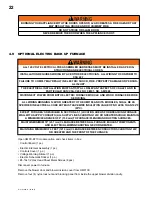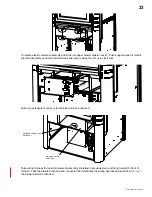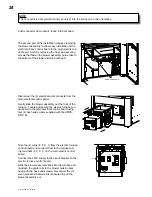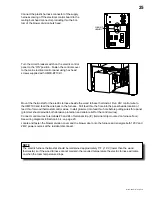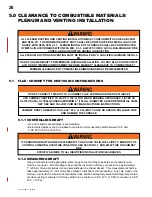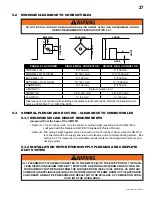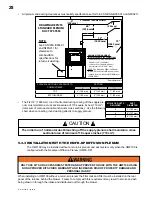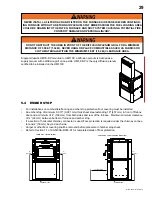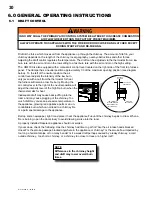
W415-1066 / A / 03.06.12
33
make sure the air control lever is in "full open" position and thermostat has a call for heat. you may also open
the doors 1" (25 mm) to 2" (50 mm) during the first five minutes of start-up, for additional information see Sec-
tion 3.2 “outside combustion Air”.
never use gasoline, gasoline-type lantern fuel, kerosene, charcoal lighter fluid, or similar liquids to start or
freshen-up a fire in this appliance. keep all such liquids well away from the appliance while it is in use. if using a
firestarter, use only products specifically designed for appliances - follow the manufacturer's instructions carefully.
Remove all source of gasoline or other flammable vapors and liquids in the vicinity of this or other ap-
pliances prior to lighting.
use plenty of newspaper and kindling to ensure the appliance reaches a proper temperature. once the kin-
dling is burning rapidly, place a few larger pieces of wood onto the fire.
Tips:
When first lighting a fire, if the smoke is not quickly drawn into the chimney, there may be a downdraft or cold
air in the chimney. by first burning large amounts of crumpled newspaper, the chimney will get heated and the
smoke will quickly vent up the chimney.
• create a large fire to heat up the appliance before adjusting to a slower burn.
• To create a large, quick burning fire, use small pieces of wood
(observe flash fire Warnings in Sections 6.1
and 6.9).
• for a lower, but extended burn, stack larger pieces of wood close together.
• for long burns, leave a 1-2” (25 - 50 mm) bed of coals.
• burn dry wood only.
•
Closing the door too quickly after refuelling will reduce the firebox temperature and may result in an
unsatisfactory burn.
• As soon as the door is closed, you may (if glass door is installed) observe a change in the flame pattern.
The flames will get smaller and lazier because less oxygen is getting into the combustion chamber. The
flames, however, are more efficient. The flames will remain lazy but become larger again as soon as the
firebricks have been heated thoroughly and the chimney becomes heated and provides a good draft.
• With the doors opened the fire is wastefully drawing heated room air up the chimney, certainly not desirable.
Always operate with the doors fully closed once the medium sized logs have caught fire.
• you can now add larger pieces of wood and operate the appliance normally. once the appliance is
entirely hot, it will burn very efficiently with little smoke from the chimney. There will be a bed of hot
coals in the firebox so you can safely fill the firebox with wood to the bottom of the secondary air tubes.
• Can’t get the appliance operating?
use more kindling and paper. Assuming the chimney and vent are
sized correctly and there is sufficient combustion air, the lack of sufficiently
dry
quantities of
small
kindling is
the problem.
thumb size
is a good gauge for small kindling diameter.
• Can’t get heat out of the appliance?
one of two things may have happened. The appliance door may
have been closed prematurely and the appliance itself has not reached optimum temperature.
re-open the door and/or draft control to re-establish a brisk fire. The other problem may have been wet
wood. The typical symptom is sizzling wood and moisture being driven from the wood.




